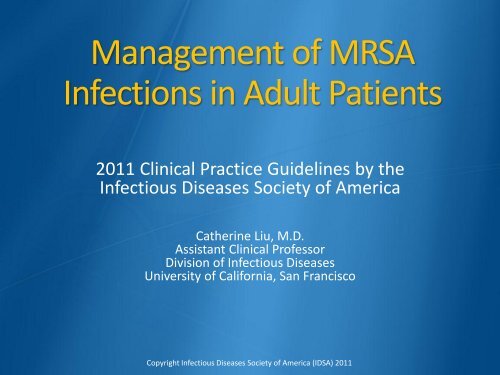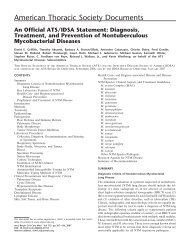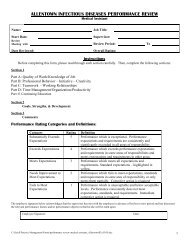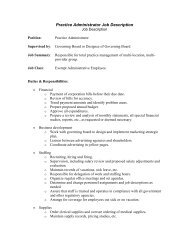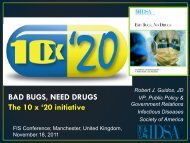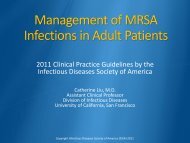Management of MRSA - Infectious Diseases Society of America
Management of MRSA - Infectious Diseases Society of America
Management of MRSA - Infectious Diseases Society of America
Create successful ePaper yourself
Turn your PDF publications into a flip-book with our unique Google optimized e-Paper software.
<strong>Management</strong> <strong>of</strong> <strong>MRSA</strong>Infections in Adult Patients2011 Clinical Practice Guidelines by the<strong>Infectious</strong> <strong>Diseases</strong> <strong>Society</strong> <strong>of</strong> <strong>America</strong>Catherine Liu, M.D.Assistant Clinical Pr<strong>of</strong>essorDivision <strong>of</strong> <strong>Infectious</strong> <strong>Diseases</strong>University <strong>of</strong> California, San FranciscoCopyright <strong>Infectious</strong> <strong>Diseases</strong> <strong>Society</strong> <strong>of</strong> <strong>America</strong> (IDSA) 2011
ObjectivesTo provide evidence-based guidance to adultand pediatric clinicians managing patients with<strong>MRSA</strong> infectionsTo discuss the management <strong>of</strong> different clinicalsyndromes caused by <strong>MRSA</strong>The guidelines do not address:<strong>MRSA</strong> infection prevention strategies in healthcaresettings (e.g. active surveillance testing,perioperative prophylaxis)<strong>Management</strong> <strong>of</strong> outbreaks in community settingsCopyright <strong>Infectious</strong> <strong>Diseases</strong> <strong>Society</strong> <strong>of</strong> <strong>America</strong> (IDSA) 2011
BackgroundPanel first convened in 2007Literature review performed via PUBMEDbetween 1961-2010: mostly clinical humanstudies, but also experimental animal modelsand in vitro studiesReviewed and endorsed by the Pediatric<strong>Infectious</strong> <strong>Diseases</strong> <strong>Society</strong>, <strong>America</strong>nAcademy <strong>of</strong> Pediatrics, and <strong>America</strong>n College<strong>of</strong> Emergency PhysiciansCopyright <strong>Infectious</strong> <strong>Diseases</strong> <strong>Society</strong> <strong>of</strong> <strong>America</strong> (IDSA) 2011
Clinical Topics1. Skin and s<strong>of</strong>t tissueinfections2. Recurrent skin and s<strong>of</strong>ttissue infections3. <strong>MRSA</strong> bacteremia andendocarditis4. <strong>MRSA</strong> pneumonia5. <strong>MRSA</strong> bone and jointinfections6. <strong>MRSA</strong> central nervoussystem infections7. Role <strong>of</strong> combination oradjunctive therapies8. Vancomycin dosing andmonitoring9. Vancomycin susceptibilitytesting10. <strong>Management</strong> <strong>of</strong> persistentbacteremia andvancomycin treatmentfailures11. <strong>MRSA</strong> neonatal infectionsCopyright <strong>Infectious</strong> <strong>Diseases</strong> <strong>Society</strong> <strong>of</strong> <strong>America</strong> (IDSA) 2011
Evidence Grading SystemStrength <strong>of</strong> recommendationABCGood evidence to support a recommendation for or against useModerate evidence to support a recommendation for or against usePoor evidence to support a recommendationQuality <strong>of</strong> evidenceIIIIIIEvidence from 1 properly randomized, controlled trialEvidence from 1 well-designed clinical trial, without randomization; from cohortor case-controlled analytic studies (preferably from > 1 center); from multiple time-series;or from dramatic results from uncontrolled experimentsEvidence from opinions <strong>of</strong> respected authorities; based on clinical experience, descriptivestudies, or reports <strong>of</strong> expert committees.Source: The periodic health examination. Canadian Task Force on the Periodic Health Examination. Health Canada, 1979.Adapted and reproduced with the permission <strong>of</strong> the Minister <strong>of</strong> Public Works and Government Services, Canada, 2009Copyright <strong>Infectious</strong> <strong>Diseases</strong> <strong>Society</strong> <strong>of</strong> <strong>America</strong> (IDSA) 2011
Case 132 y/o M with 3 days <strong>of</strong>an enlarging, painfullesion on his L thighthat he attributes to a“spider bite”.T 36.9 BP 118/70 P 82Copyright <strong>Infectious</strong> <strong>Diseases</strong> <strong>Society</strong> <strong>of</strong> <strong>America</strong> (IDSA) 2011
What is the appropriatemanagement <strong>of</strong> this patient?A. Incision and drainage aloneB. Incision and drainage plus oral anti-<strong>MRSA</strong> antimicrobial agentC. Oral anti-<strong>MRSA</strong> antimicrobial agentCopyright <strong>Infectious</strong> <strong>Diseases</strong> <strong>Society</strong> <strong>of</strong> <strong>America</strong> (IDSA) 2011
AbscessesIncision and drainage is the primary treatment (AII).For simple abscesses or boils, I&D alone likely adequateDo antibiotics provide additional benefit?Multiple, observational studies: high cure rates with or without abx3 RCTs <strong>of</strong> uncomplicated skin abscesses; 2 large NIH trials ongoingp=.25p=.12p=.52cephalexinTMP-SMXTMP-SMXRajendran AAC 2007; 51:4044-8; Duong Ann Emerg Med 2009;55:401-7; Schmitz Ann Emerg Med 2010; 56:283-7Copyright <strong>Infectious</strong> <strong>Diseases</strong> <strong>Society</strong> <strong>of</strong> <strong>America</strong> (IDSA) 2011
Is clinical cure the only important endpoint?p=.04 p=.58 p=.02Duong Ann Em Med 2009;55:401-7; Schmitz Ann Em Med 2010; 56:283-7; Talan Ann Em Med 2010; 55:412-14;Spellburg Ann Em Med 2011; 57:183-4.Copyright <strong>Infectious</strong> <strong>Diseases</strong> <strong>Society</strong> <strong>of</strong> <strong>America</strong> (IDSA) 2011
Antibiotic therapy is recommended forabscesses associated with:Severe, extensive disease, rapidlyprogressive with associated cellulitis orseptic phlebitisSigns & sx <strong>of</strong> systemic illnessAssociated comorbidities,immunosuppressedExtremes <strong>of</strong> ageDifficult to drain area (e.g. face, hand,genitalia)Failure <strong>of</strong> prior I&D(AIII)Copyright <strong>Infectious</strong> <strong>Diseases</strong> <strong>Society</strong> <strong>of</strong> <strong>America</strong> (IDSA) 2011
Microbiology <strong>of</strong> Purulent SSTIsnon-B hemolyticstrep4%other8%unknown9%B-hemolyticstrep3%MSSA17%<strong>MRSA</strong>59%Moran NEJM 2006; 355: 666-74Copyright <strong>Infectious</strong> <strong>Diseases</strong> <strong>Society</strong> <strong>of</strong> <strong>America</strong> (IDSA) 2011
Case 228 year old womanpresents with erythema<strong>of</strong> her right arm overpast 48 hours. There isno purulent drainage,exudate or abscess. Noevidence <strong>of</strong> joint orbursa involvement.T 37.0 BP 132/70 P 78Courtesy <strong>of</strong> Thomas Sellers, MD,CDC/ Emory UniversityCopyright <strong>Infectious</strong> <strong>Diseases</strong> <strong>Society</strong> <strong>of</strong> <strong>America</strong> (IDSA) 2011
What is the appropriate management <strong>of</strong> thispatient?A. Clindamycin 300 mg PO tidB. Cephalexin 500 mg QID, monitor clinically withaddition <strong>of</strong> TMP/SMX if no responseC. Cephalexin 500 mg QID and TMP/ SMX 2 DStab PO bidCopyright <strong>Infectious</strong> <strong>Diseases</strong> <strong>Society</strong> <strong>of</strong> <strong>America</strong> (IDSA) 2011
Nonpurulent Cellulitis:-hemolytic strep vs. S. aureus?Empiric Rx for -hemolytic strep recommended (AII)Prospective study 1 , 248 hospitalized pts73% due to -hemolytic strep (diagnosis by serologies for ASO andanti-DNAse-B, blood cultures); 27% with no identified cause.Overall 96% response rate to -lactam antibiotic.Retrospective study 2 treatment failures with TMP-SMX vs. -lactam or clindamycinThe role <strong>of</strong> CA-<strong>MRSA</strong> is unknown.Empiric Rx for <strong>MRSA</strong> if fails to respond to -lactamConsider in patients with systemic toxicity1Jeng et al Medicine 2010; 89:217-26 2 Elliott et al Pediatrics 2009; 123:e959-66Copyright <strong>Infectious</strong> <strong>Diseases</strong> <strong>Society</strong> <strong>of</strong> <strong>America</strong> (IDSA) 2011
Outpatient nonpurulent cellulitis: EmpiricRx for -hemolytic streptococci +/- <strong>MRSA</strong>DrugCephalexinDicloxacillinClindamycin*Linezolid**Also have activity against CA-<strong>MRSA</strong>Adult Dose500 QID500 QID300-450 TID600 BIDCopyright <strong>Infectious</strong> <strong>Diseases</strong> <strong>Society</strong> <strong>of</strong> <strong>America</strong> (IDSA) 2011
Complicated SSTI• Surgical debridement & empiric therapy for<strong>MRSA</strong> pending culturesAntibiotic Adult EvidenceGradeVancomycin15-20 mg/kg IV Q8-12 AILinezolid 600 mg PO/ IV BID AIDaptomycin 4 mg/kg IV QD AITelavancin 10 mg/kg IV QD AIClindamycin 600 mg PO/IV Q8 AIII*Tigecycline associated with mortality; consider alternate agent for <strong>MRSA</strong> SSTI*Ceftaroline: FDA approved after guidelinesCopyright <strong>Infectious</strong> <strong>Diseases</strong> <strong>Society</strong> <strong>of</strong> <strong>America</strong> (IDSA) 2011
Case 3The patient in case 1 returns 4 weeks later withanother abscess on his opposite thigh. He notesthat after I & D <strong>of</strong> his first abscess, he didn’tkeep his wound covered and occasionallytouched the site to “make sure it was healing.”The site <strong>of</strong> his old abscess is clean with a wellhealedscar. He undergoes I&D and receives 1week <strong>of</strong> TMP-SMX.Copyright <strong>Infectious</strong> <strong>Diseases</strong> <strong>Society</strong> <strong>of</strong> <strong>America</strong> (IDSA) 2011
What is the appropriate management<strong>of</strong> this patient?A. Emphasize personal hygiene measuresB. Decolonize with mupirocin andchlorhexidine showersC. Decolonize with TMP-SMX andrifampinD. A and BE. A, B, and CCopyright <strong>Infectious</strong> <strong>Diseases</strong> <strong>Society</strong> <strong>of</strong> <strong>America</strong> (IDSA) 2011
What is the <strong>Management</strong> <strong>of</strong> RecurrentSkin and S<strong>of</strong>t Tissue Infections?HostEnvironmentPathogenCopyright <strong>Infectious</strong> <strong>Diseases</strong> <strong>Society</strong> <strong>of</strong> <strong>America</strong> (IDSA) 2011
What is the <strong>Management</strong> <strong>of</strong> Recurrent Skin andS<strong>of</strong>t Tissue Infections?Personal Hygiene/ Wound Care (AIII)Host-Cover draining wounds-Hand hygiene after touching infected skin-Avoid reusing/ sharing personal items ifactive infectionEnvironmental Hygiene (CIII)-Clean high-touch surfacesEnvironmentPathogen*Decolonization (CIII)-If above measuresfail-If ongoinghouseholdtransmissionCopyright <strong>Infectious</strong> <strong>Diseases</strong> <strong>Society</strong> <strong>of</strong> <strong>America</strong> (IDSA) 2011
Recurrent <strong>MRSA</strong> SSTI: DecolonizationRegimensMupirocin twice daily x 5-10 days (CIII) recurrent MSSA SSTI in small RCT 1RCT military recruits: in CA-<strong>MRSA</strong> nasal colonization butnot 1 st time SSTI 2Mupirocin twice daily x 5-10 days AND topical skinantiseptic (e.g. chlorhexidine) x 5-14 days (CIII)RCT military recruits: CHG wipes alone not SSTI rates 3 ,transient effect on colonizationConsider dilute bleach baths: ¼ cup per ¼ tub (13 gallons) <strong>of</strong>water for 15 min, 2x/week for 3 mnths1Raz Arch Intern Med 1996; 156:1109-12; 2 Ellis MW AAC 2007; 51: 3591-8 3 Whitman ICHE 2010; 12: 1207-15Copyright <strong>Infectious</strong> <strong>Diseases</strong> <strong>Society</strong> <strong>of</strong> <strong>America</strong> (IDSA) 2011
Oral Antibiotics for Decolonization?Not routinely recommended for decolonization (AIII). Anoral agent in combination with rifampin (if susceptible)may be considered if infections recur despite othermeasures (CIII).Cochrane review 1 : No benefit <strong>of</strong> oral abx in <strong>MRSA</strong>eradication among patients in healthcare settingsSystematic review 2 : Rifampin + staph abx vs. staphabx alone• Rifampin combo superior in S. aureus colonization• No studies evaluated impact on infection ratesWatch out for drug interactions, side effects,resistance1Cochrane Review 2003; 4CD003340 2 Falagas ME AJIC 2007; 35: 106-14Copyright <strong>Infectious</strong> <strong>Diseases</strong> <strong>Society</strong> <strong>of</strong> <strong>America</strong> (IDSA) 2011
Case 435 y/o F previously healthywith 4 days <strong>of</strong> fever, chills,myalgias, and cough. Nowwith increasing dyspnea andhemoptysis x 24 hrsT38.7 P120 BP96/60 R2489%RAModerate respiratory distresswith coarse rhonchiWBC 15, Hct 44, Plt 425Rapid flu: + influenza ASputum gram stain/ cx:pendingIntubated, admitted to ICUCourtesy <strong>of</strong> Thomas File MDCopyright <strong>Infectious</strong> <strong>Diseases</strong> <strong>Society</strong> <strong>of</strong> <strong>America</strong> (IDSA) 2011
In addition to starting anti-influenza therapy,would you treat with antibiotics and if sowhich?A. NoneB. Ceftriaxone and azithromycinC. Vancomycin and ceftriaxone andazithromycinD. Linezolid and cefepimeCopyright <strong>Infectious</strong> <strong>Diseases</strong> <strong>Society</strong> <strong>of</strong> <strong>America</strong> (IDSA) 2011
<strong>MRSA</strong> pneumoniaAntibiotic Adult EvidenceGradeVancomycinLinezolid15-20 mg/kg IVQ8-12AII600 mg PO/ IV BID AIIClindamycin 600 mg PO/IV TID BIIIJung Crit Care Med 2010Copyright <strong>Infectious</strong> <strong>Diseases</strong> <strong>Society</strong> <strong>of</strong> <strong>America</strong> (IDSA) 2011
<strong>MRSA</strong> pneumonia: Vancomycin vs. Linezolid?p= NS p= NSp
<strong>MRSA</strong> pneumoniaDaptomycin should not be used for Rx <strong>of</strong> pneumonia,(inactivated by pulmonary surfactant)Daptomycin may be used in patients withhematogenous septic pulmonary emboli 1Empiric Rx for <strong>MRSA</strong> recommended for severe CAP(ICU admission, necrotizing or cavitary infiltrates, orempyema)Discontinue empiric Rx if cultures do not grow<strong>MRSA</strong>Duration <strong>of</strong> therapy: 7-21 days1Rehm JAC 2008;62:1413-21; Silverman JID 2005; 191:2149-52Copyright <strong>Infectious</strong> <strong>Diseases</strong> <strong>Society</strong> <strong>of</strong> <strong>America</strong> (IDSA) 2011
Case 560 year old male prison inmate presents with 4 days <strong>of</strong>fevers and chills and decreased L eye vision.T 38.5 BP 102/71 P 104 R 20 O2 sat 98% RA weight 100kgEye: Bilateral creamy white-yellow discharge, vitreousstrands/ infiltrates, L eye - intraretinal hemorrhageHeart: 2/6 systolic murmur at apexChest: CTABSkin: no peripheral stigmata <strong>of</strong> endocarditisLabs: 15.5> 39 > 350 Cr 0.8Started on IV vancomycin 1 gram every 12 hoursCopyright <strong>Infectious</strong> <strong>Diseases</strong> <strong>Society</strong> <strong>of</strong> <strong>America</strong> (IDSA) 2011
Case continuedHD #1 blood cx: 3/4 <strong>MRSA</strong> (vanco MIC 1)Received intravitreal injection <strong>of</strong> vancomycinHD # 5T 37.8 BP 138/70 P 113 R 16 O2 sat 96% RAAlert and interactive, no new physical examfindingsBlood cx: 2/2 <strong>MRSA</strong> (vanco MIC 1)Vancomycin trough 7 g/mLCopyright <strong>Infectious</strong> <strong>Diseases</strong> <strong>Society</strong> <strong>of</strong> <strong>America</strong> (IDSA) 2011
Echocardiogram2 cm mitral valve vegetationCopyright <strong>Infectious</strong> <strong>Diseases</strong> <strong>Society</strong> <strong>of</strong> <strong>America</strong> (IDSA) 2011
Brain MRICopyright <strong>Infectious</strong> <strong>Diseases</strong> <strong>Society</strong> <strong>of</strong> <strong>America</strong> (IDSA) 2011
What changes to the patient’s antibioticsshould be made?A. Add gentamicin to vancomycinB. Add rifampin to vancomycinC. Increase vancomycin dose to 1.5 gram IV Q12hrs, target goal trough <strong>of</strong> 15-20 g/mLD. Discontinue vancomycin and start IVdaptomycin 6 mg/kg Q24 hrsCopyright <strong>Infectious</strong> <strong>Diseases</strong> <strong>Society</strong> <strong>of</strong> <strong>America</strong> (IDSA) 2011
<strong>MRSA</strong> bacteremia and endocarditisIV vancomycin (AII) or IV daptomycin 6 mg/kg QD (AI).236 pts randomized to IV daptomycin 6 mg/kg QD vs. (vancomycinor nafcillin) + gentamicin 1 mg/kg Q8 x 4 daysSome experts recommend IV daptomycin 8-10 mg/kg QD (BIII).Fowler VG NEJM 2006; 355: 653-65Copyright <strong>Infectious</strong> <strong>Diseases</strong> <strong>Society</strong> <strong>of</strong> <strong>America</strong> (IDSA) 2011
Is there a role for adjunctive gentamicin orrifampin? More is not always better…Addition <strong>of</strong> gentamicin (AII) or rifampin (AI) to vancomycin isnot recommended. No clear evidence <strong>of</strong> benefit.Vanco +rifampin: 1 RCT <strong>MRSA</strong> endocarditis 1Vancomycin Vancomycin + rifampin p-valueTreatment failures 4/ 22 (18%) 2/20 (10%) >.05Median duration <strong>of</strong>bacteremiaMedian duration <strong>of</strong>fever7 days (5-11) 9 days (6-13) >.057 days (3-8) 7 days (3-10) >.05Vanco + gentamicin: in vitro data, but no clinical studies.Nafcillin + gent vs. nafcillin RCT MSSA bacteremia: duration <strong>of</strong> bacteremiax 1 day but no difference in morbidity/ mortality 21Levine. Ann Intern Med 1991;115:674-80; 2 Korzeniowski. Ann Intern Med 1982;4:496-503Copyright <strong>Infectious</strong> <strong>Diseases</strong> <strong>Society</strong> <strong>of</strong> <strong>America</strong> (IDSA) 2011
Addition <strong>of</strong> gentamicin or rifampin tovancomycin is associated with toxicity risk <strong>of</strong> nephrotoxicity with initial low-dose gentamicin 1*Gentamicin was anindependent predictor<strong>of</strong> clinically significant in CrCl risk <strong>of</strong> elevated transaminases (≥ 5X baseline), druginteractions with rifampin, resistance concerns 21Fowler NEJM 2006;355:653-65; Cosgrove S CID 2009;48:713-21; 2 Riedel D AAC 2008;52:2463-7Copyright <strong>Infectious</strong> <strong>Diseases</strong> <strong>Society</strong> <strong>of</strong> <strong>America</strong> (IDSA) 2011
<strong>MRSA</strong> bacteremia and endocarditis: Sourcecontrol is criticalIdentify source and extent <strong>of</strong> infection; eliminate anddebride other sites <strong>of</strong> infection (AII).Repeat blood cultures 2-4 days after initial positivecultures and as needed thereafter to document clearance<strong>of</strong> bacteremia (AII).Echocardiography recommended for all patients withbacteremia (AII). TEE is preferred over TTE.Evaluate for valve replacement surgery if:vegetation > 10 mm, ≥ 1 embolic event, severe valvularinsufficiency, valvular perforation, decompensated heartfailure, perivalvular/ myocardial abscess, new heart blockCopyright <strong>Infectious</strong> <strong>Diseases</strong> <strong>Society</strong> <strong>of</strong> <strong>America</strong> (IDSA) 2011
Duration <strong>of</strong> therapyLower success rates in pts receiving < 14 days <strong>of</strong>therapy have been observedUncomplicated bacteremia: Minimum duration is 2weeks if:Exclude endocarditisNo implanted prostheses (e.g. prosthetic valves, cardiacdevices, arthroplasties)Negative follow-up blood cultures for <strong>MRSA</strong> at 2-4 daysDefervescence within 72 hours <strong>of</strong> therapyNo evidence <strong>of</strong> metastatic sites <strong>of</strong> infectionComplicated bacteremia (if do not meet abovecriteria): 4-6 weeks1Fowler NEJM 2006;355:653-65; Cosgrove CID 2008;46:S386-93Copyright <strong>Infectious</strong> <strong>Diseases</strong> <strong>Society</strong> <strong>of</strong> <strong>America</strong> (IDSA) 2011
Vancomycin DosingIV vancomycin 15-20 mg/kg (actual body weight)every 8-12 hrs, not to exceed 2 g per dose (BIII).In seriously ill patients with suspected <strong>MRSA</strong>infection, a loading dose <strong>of</strong> 25-30 mg/kg (actual bodyweight) may be considered (CIII).Given risk <strong>of</strong> red man syndrome and possible anaphylaxisassociated with large doses, consider prolonging infusiontime 2 h and pre-medication with antihistamine .Continuous infusion vancomycin is unlikely tosubstantially improve patient outcome, comparedwith intermittent dosing (AII).Copyright <strong>Infectious</strong> <strong>Diseases</strong> <strong>Society</strong> <strong>of</strong> <strong>America</strong> (IDSA) 2011
Vancomycin Therapeutic Drug MonitoringObtain serum troughs at steady state (b/f 4 th or 5 thdose) (BII).Monitoring <strong>of</strong> peak vancomycin concentrations is notrecommended (BII).For serious infections (e.g. bacteremia, endocarditis,osteomyelitis, pneumonia, severe SSTI [nec fasc]),target vancomycin trough concentrations <strong>of</strong> 15-20g/mL (BII).For most patients with SSTI with normal renal functionand not obese, traditional doses <strong>of</strong> 1 g Q12 areadequate and trough monitoring is not required (BII).Moise-Broder Clin Pharmacok 2004;43:925-42; Jeffres Chest 2006; 130:947-55; Arbeit R CID 2004;38:1673-81; Weigelt AAC2005; 49:2260-6; Stryjewski CID 2008;46:1683-93; Lipsky JAC 2005;55:240-5; Breedt AAC 2005; 49:4658-66Copyright <strong>Infectious</strong> <strong>Diseases</strong> <strong>Society</strong> <strong>of</strong> <strong>America</strong> (IDSA) 2011
A few words on Vanco MICs….Mohr CID 2007;44:1536-42Probability <strong>of</strong> achieving target AUC/ MIC is 0% if vancomycin MIC= 2 µg/mL with low or high-dose vancomycinVanco MICs <strong>of</strong> 2 µg/mL associated with vanco Rx failures 1“MIC creep” observed in some centers but not others 2Perhaps due to clonal dissemination or technical artifact1Sakoulas JCM 2004;42:2398-402; Hidayat L Arch Intern Med 2006;166:2138-44; Lodise AAC 2008;52:3315-20; Maor JID2009;199:619-24 2 Alos JAC 2008;62:773-5; Holmes AAC 2008;52:757-60; Jones CID 2006;42:S13-24; Sader AAC 2009;53:4127-32Copyright <strong>Infectious</strong> <strong>Diseases</strong> <strong>Society</strong> <strong>of</strong> <strong>America</strong> (IDSA) 2011
Detection <strong>of</strong> Isolates with VancomycinMIC <strong>of</strong> ≤ 2 µg/mLSader AAC 2009; 53:4127-32N=1800Copyright <strong>Infectious</strong> <strong>Diseases</strong> <strong>Society</strong> <strong>of</strong> <strong>America</strong> (IDSA) 2011
How should Vancomycin MIC Results beused to Guide Therapy?For isolates with a vanco MIC ≤ 2 µg/mL, the patient’sclinical response should determine continued use <strong>of</strong>vancomycin, independent <strong>of</strong> the MIC (AIII).If clinical and microbiological response to vanco,continue with close follow-upIf no clinical or microbiologic response despiteadequate debridement and removal <strong>of</strong> other foci <strong>of</strong>infection, alternative to vancomycin is recommendedregardless <strong>of</strong> MIC.For isolates with a vancomycin MIC 2 µg/mL (VISA orVRSA), an alternative to vancomycin should be used (AIII).Copyright <strong>Infectious</strong> <strong>Diseases</strong> <strong>Society</strong> <strong>of</strong> <strong>America</strong> (IDSA) 2011
Case continued…Vancomycin dose increased to 1.5g Q 12 hoursHD #6 blood cx: 2/2 <strong>MRSA</strong> (vanco MIC 1),vanco trough 13 (drawn before 3 rd dose)HD #8 blood cx: 2/2 <strong>MRSA</strong> (vanco MIC 1, daptoMIC ≤ 0.5)HD #9 blood cx: prelim 1/ 2 Staph sppT37.2 BP132/84 HR94 R18 O295-100% RAR eye –retinal detachmentNo other significant changes to physical examRepeat Echo: vegetation size with longer mobileelement and extension along the annulusCopyright <strong>Infectious</strong> <strong>Diseases</strong> <strong>Society</strong> <strong>of</strong> <strong>America</strong> (IDSA) 2011
In addition to CT surgery eval, what changesto the patient’s antibiotics, if any, should bemade?A. No changes to his antibiotics should be madeB. Add gentamicin to vancomycinC. Discontinue vancomycin and start IV daptomycin8 mg/kg Q24 hrsD. Discontinue vancomycin and start IV daptomycin8 mg/kg Q24 hrs + linezolid 600 mg BIDCopyright <strong>Infectious</strong> <strong>Diseases</strong> <strong>Society</strong> <strong>of</strong> <strong>America</strong> (IDSA) 2011
Defining Vancomycin Treatment Failure: Approachto Persistent <strong>MRSA</strong> BacteremiaMedian time to clearance <strong>of</strong> bacteremia 1,2,3 :MSSA with -lactam abx<strong>MRSA</strong> with vancomycin,daptomycin3-4 days7-9 daysConsideration factors when contemplating change in therapy:Patient’s overall clinical responseVancomycin trough concentrationsResults <strong>of</strong> susceptibility testing (e.g. vanco MIC)Presence <strong>of</strong> and ability to remove other foci <strong>of</strong> infection1Korzeniowski Ann Intern Med 1982;4:496-50; 2 Levine Ann Intern Med 1991;115:674-80;3Fowler NEJM 2006;355:653-65Copyright <strong>Infectious</strong> <strong>Diseases</strong> <strong>Society</strong> <strong>of</strong> <strong>America</strong> (IDSA) 2011
<strong>Management</strong> <strong>of</strong> Persistent <strong>MRSA</strong>Bacteremia on Vancomycin TherapyConsider change in therapy if:1) Unsatisfactory clinicalresponse, regardless <strong>of</strong> MICor2) Vanco MIC = 2No change in therapy if:1) Clinically respondingand2) Vanco MIC < 21 2 3 4 5 6 7 8 9 10 11 12 13Day <strong>of</strong> vancomycin therapyCopyright <strong>Infectious</strong> <strong>Diseases</strong> <strong>Society</strong> <strong>of</strong> <strong>America</strong> (IDSA) 2011
Persistent <strong>MRSA</strong> Bacteremia/ VancomycinTreatment Failures: Therapeutic ConsiderationsIn general, recommend a change in therapy rather than addition<strong>of</strong> other agents (e.g. rifampin/ gentamicin) to vancoHigh-dose daptomycin (10 mg/kg/day), if susceptible, incombination with another agent (BIII):Gentamicin 1 mg/kg IV Q8Rifampin 600 mg PO/ IV QD or 300-450 mg PO/ IV twice dailyLinezolid 600 mg PO/ IV BIDTMP-SMX 5 mg/kg IV BID-lactam antibioticNote: prior vanco exposure and elevated vanco MICs associatedwith dapto MICs (> 1 µg/mL).LaPlante K AAC 2004;48:4665-72;Tsuji BT AAC 2005;49:2735-45;Credito AAC 2007;51:1504-7; Baltch A AC 2008;52:1829-33;Rose W AAC 2008;52:831-6;Falagas ME JAC 2006;58:273-80;Steed AAC 2010;54:5187-92;Yang AAC 2010; 54:3161-9Copyright <strong>Infectious</strong> <strong>Diseases</strong> <strong>Society</strong> <strong>of</strong> <strong>America</strong> (IDSA) 2011
How to manage reduced susceptibility tovancomycin and daptomycin?Quinupristin-dalfopristin 7.5 mg/kg/dose IV Q8 (CIII)Used successfully in vanco Rx failures, but lower response rates forendocarditis and bacteremia <strong>of</strong> unknown sourceTMP-SMX 5 mg/kg/dose IV BID (CIII)In vitro study: combo <strong>of</strong> dapto + TMP-SMX vs. dapto alone had morerapidly bactericidal activity for a dapto non-susceptible strainLinezolid 600 mg PO/ IV BID (CIII)Case series suggest success when used alone or in combination withother abx; poor outcomes for left-sided endocarditis.Telavancin 10 mg/kg/dose IV QD (CIII)1 case report <strong>of</strong> persistent <strong>MRSA</strong> bacteremia successfully treatedSander A Int Care Med 2002;28:1157-60; Markowitz N Ann Intern Med 1992;117:390-8; Steed AAC 2010;54:5187-92; FalagasME JAC 2006;58:273-80; Nace JAC 2010;65:1315-6.Copyright <strong>Infectious</strong> <strong>Diseases</strong> <strong>Society</strong> <strong>of</strong> <strong>America</strong> (IDSA) 2011
Case follow-upHD #9 blood cultures: 1/ 2 <strong>MRSA</strong>Daptomycin + linezolid startedR vitrectomy performedHD #11 blood cultures : negativeHD #15 OR for valve replacement surgeryIntraoperative cultures mitral valve vegetation: + <strong>MRSA</strong>Complicated course: status epilepticus, ventilatorassociatedpneumonia, PEA arrest 2 tosubmassive PE, eventually recovered anddischarged to SNFReceived daptomycin 10 mg/kg QD + rifampin 300mg TID for 6 weeks after MVR.Copyright <strong>Infectious</strong> <strong>Diseases</strong> <strong>Society</strong> <strong>of</strong> <strong>America</strong> (IDSA) 2011
<strong>MRSA</strong> bone and joint infectionsSurgical debridement is mainstay <strong>of</strong> therapy (AII).Antibiotic Dose Evidence gradeVancomycin 15-20 mg/kg IV Q8-12 BIIDaptomycin 6 mg/kg IV QD BIILinezolid 600 mg PO/ IV BID BIITMP-SMX +rifampin4 mg/kg/dose (TMP) BID600 mg QD (rifampin)Some experts recommend adding rifampin 300-450BID:Animal models, small human trials <strong>of</strong> MSSA osteomyelitisRetrospective study: cure rate <strong>of</strong> 80%, no added benefit ifdebridement occurredBIIClindamycin 600 mg PO/ IV Q8 BIIIPerlroth Arch Intern Med 2008;168:805-19;Dombrowski J Infect 2008;57:110-5; Livorsi J Infect 2008;57:128-31Copyright <strong>Infectious</strong> <strong>Diseases</strong> <strong>Society</strong> <strong>of</strong> <strong>America</strong> (IDSA) 2011
Oral vs. IV vs. IV/ PO therapy?Optimal route <strong>of</strong> administration notestablished (AII).Chronic non-axial MSSA osteo, randomized trial 1IV cloxacillin(6 wks IV/ 2 wks PO)PO cotrimoxazole +rifampin X 8 wksP-valueCure rate 91% 89% 1.0Retrospective cohort (<strong>MRSA</strong> subset) 2IV (median 6 wks)*IV (median 2 wks), thenPO (median 42 days)P-valueCure rate 65% 65% .99*61 % also received oral therapy for median PO 21 days** Median total duration <strong>of</strong> total therapy 60 and 56 days in both groups1Euba AAC 2009;53:4305-10; 2 Daver J Infect 2007;54:539-44Copyright <strong>Infectious</strong> <strong>Diseases</strong> <strong>Society</strong> <strong>of</strong> <strong>America</strong> (IDSA) 2011
Duration <strong>of</strong> therapy?Optimal duration is unknown; minimum 8 wks(AII).Hematogenous MSSA vertebral osteo: 8 wksvs < 8 wks associated with improvedoutcomes 1,2Some experts suggest an additional 1-3months (and possibly longer for chronicinfection or if no debridement) <strong>of</strong> oralrifampin-based combination therapy (CIII)1Jensen Arch Intern Med 1998;158:509-17; 2 Priest S Med J 2005;98:854-62Copyright <strong>Infectious</strong> <strong>Diseases</strong> <strong>Society</strong> <strong>of</strong> <strong>America</strong> (IDSA) 2011
<strong>MRSA</strong> Infections <strong>of</strong> the Central NervousSystemTreatment difficult due to blood-brain barrierAntibioticVancomycin(BII)Linezolid(BII)TMP-SMX(CIII)CSFpenetrationCSF concentrationComment1-5% 2-6 µg/mL Some experts recommendadding rifampin 1 (BIII)66% Peak 7-10 µg/mLTrough 2.5-6 µg/mLTMP 13-53%SMX 17-63%TMP 1.9-5.7 µg/mLSMX 20-63 µg/mLSuccessful use in few casereports, small case series 2Few case reports, only MSSA 31Von Specht EJCMID 2006;25:267-9; Dylewski J CJIDMM 2004;15:336-8; Pintado EJCMID 2002;21:864-8; 2 Ntziora AnnPharm 2007;41:296-308; Gallagher J Infect 2008;57-410-3; 3 Vartzelis Infect 2005;33:36-8; Levitz Ann Intern Med 1984;100:881-90Copyright <strong>Infectious</strong> <strong>Diseases</strong> <strong>Society</strong> <strong>of</strong> <strong>America</strong> (IDSA) 2011
<strong>Management</strong> <strong>of</strong> <strong>MRSA</strong> infections <strong>of</strong> theCentral Nervous SystemCNS Shunt infections/ meningitisShunt removal is recommended; replace only whenCSF cultures are repeatedly negative (AII).Intraventricular vancomycin or daptomycin may beconsidered if not responding to systemic therapy 1 .Brain abscess, subdural empyema, spinal epidural abscessNeurosurgical evaluation for incision and drainage(AII).Septic cavernous or dural venous sinus thrombosisDebride contiguous sites <strong>of</strong> infection or abscess (AII).Role <strong>of</strong> anticoagulation controversial due to risk <strong>of</strong>intracranial hemorrhage1Pfausler J Neurosurg 2003;98:1040-4; Amod J Infect 2005; 50:252-7;Elvy JAC 2008;61:46102Copyright <strong>Infectious</strong> <strong>Diseases</strong> <strong>Society</strong> <strong>of</strong> <strong>America</strong> (IDSA) 2011
Adjunctive Therapies in Treatment <strong>of</strong> <strong>MRSA</strong>InfectionsProtein synthesis inhibitors (e.g.clindamycin and linezolid) and IVIG are notroutinely recommended as adjunctivetherapy (AIII).Limited in vitro data, animal model data(some conflicting)Some experts may consider these agents inselected scenarios (e.g. necrotizingpneumonia or severe sepsis.) (CIII).Copyright <strong>Infectious</strong> <strong>Diseases</strong> <strong>Society</strong> <strong>of</strong> <strong>America</strong> (IDSA) 2011
Performance MeasuresThe management <strong>of</strong> all <strong>MRSA</strong> infections should includeidentification, elimination, and/or debridement <strong>of</strong> theprimary source and other sites <strong>of</strong> infection when possibleIn patients with <strong>MRSA</strong> bacteremia, document clearance <strong>of</strong>bacteremia (follow-up blood cultures 2-4 days after initialpositive cx and as needed thereafter)Vancomycin should be dosed according to actual bodyweight (15-20 mg/kg/dose every 8-12h), not to exceed 2gram per dose. Target trough <strong>of</strong> 15-20 g/mL in patientswith serious infectionsDocument in vitro susceptibility when an alternative tovancomycin is being consideredFor MSSA infections, a -lactam antibiotic is the drug <strong>of</strong>choiceCopyright <strong>Infectious</strong> <strong>Diseases</strong> <strong>Society</strong> <strong>of</strong> <strong>America</strong> (IDSA) 2011
IDSA GuidelinesThis resource is based on an IDSA practice guideline. The practiceguideline and this presentation are not intended to substitute forthe independent pr<strong>of</strong>essional judgment <strong>of</strong> the treating physician.It is important to realize that guidelines cannot always account forindividual variation among patients. They are not intended tosupplant physician judgment with respect to particular patients orspecial clinical situation. IDSA considers adherence to its guidelinesto be voluntary, with the ultimate determination regarding theirapplication to be made by the physician in the light <strong>of</strong> eachpatient's individual circumstances.The full practice guideline and additional resources are available at:www.idsociety.org/IDSA_Practice_Guidelines/Copyright <strong>Infectious</strong> <strong>Diseases</strong> <strong>Society</strong> <strong>of</strong> <strong>America</strong> (IDSA) 2011


